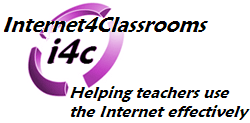
 |
Links for K-12 Teachers | Assessment Assistance | On-Line Practice Modules | Daily Dose of the Web
Using the Apple Items Menu and other Desktop items
Apple Menu Items - The multicolor Apple logo is found in the top left corner of a Macintosh computer screen. That is not an advertisement, it is a menu of items built into the Mac, or an alias for opening an application. After you become more familiar with your Mac you might want to add an alias in that menu list. The image below shows some of the built in features as well as some that have been added. PC users, this area is analogous to the Start menu. This image is clickable. To find out more about an item, place the tip of your mouse pointer on it and gently click one time. Note: Not all items are clickable.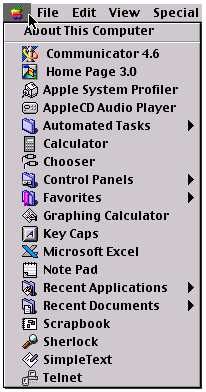 About this Computer - Do you want to know some of the basics about your computer? Things like How much memory is built in to the computer, or which version of the Macintosh operating system you are running? This is the place to find it. In the window below, notice that you can also see how much memory each currently running application is using. One caution about this window. You can only see it when you also see the word Finder in the top right corner of the macintosh screen. When Finder is what you see there, all running applications are inactive.If Netscape is the currently active application, that part of the Apple Items menu becomes About Netscape.
About this Computer - Do you want to know some of the basics about your computer? Things like How much memory is built in to the computer, or which version of the Macintosh operating system you are running? This is the place to find it. In the window below, notice that you can also see how much memory each currently running application is using. One caution about this window. You can only see it when you also see the word Finder in the top right corner of the macintosh screen. When Finder is what you see there, all running applications are inactive.If Netscape is the currently active application, that part of the Apple Items menu becomes About Netscape.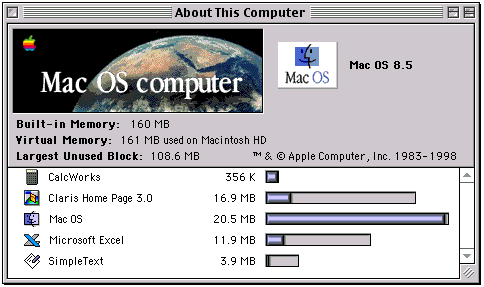
Apple System Profiler - If you need more information than can be found in About This Computer, this is the place!
Calculator - A simple four function calculator. To see more about this feature, go back to the page about Built-In items. When you finish reviewing close the window to come back to this page.
Chooser - If you need to select any item on the network, this is where it is done. You can connect to any shared items on other computers, or change to a different printer.
Control Panels - Changes can be made here to almost anything about your Mac. Caution. If you make changes, change only one thing at a time. You may not like the change.
Favorites - Aliases of applications which are used often can be stored in this area.
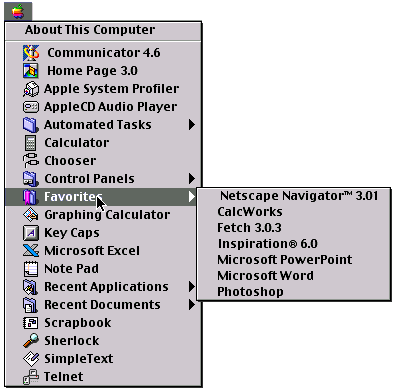
Key Caps - Many special characters are available from your keyboard. You can type much more than a, b, c if you know a combination of keystrokes. Launch Key Caps and change the font to Wingdings, and find the key that represents
or any other symbol you might want to type.
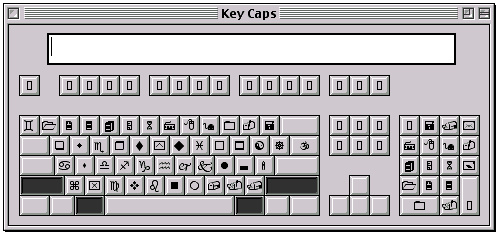
Recent Applications - A listing of the most recent applications opened on the mac.
Recent Documents - A listing of the most recent documents produced and saved on the mac.
Scrapbook - A place to store images quickly. To see more about this feature, go back to the page about Built-In items. When you finish reviewing close the window to come back to this page.
Sherlock - Find anything stored on your computer, or search the Internet with this neat Macintosh search tool.
Simple Text - A text only word processor. To see more about this feature, go back to the page about Built-In items. When you finish reviewing close the window to come back to this page.
Hard Drive - To see everything that is installed on your computer, go into the Hard Drive icon. That icon is located in the top right part of the screen. The icon on my screen looks like this:
Place the tip of your mouse pointer in the center of this icon and gently click two times quickly. When the hard drive opens you can see the contents in one of three possible views.
Icon view - Many Macintosh users like seeing the contents of their computer in the form of icons. Individual files or documents stored on your computer will have the icon of the application in which they were created. The advantage of this view is that it is easy to spot application specific folders or documents. The disadvantage is that you can see only a small portion of the contents without scrolling. Most new users stick with this view for a while.
Button view - Each application or document icon is placed on a 3-D looking button. The disadvantage mentioned for the icon view is exaggerated in this view. I personally can not see a good reason for using this view. If you have a good one, please send an Email message about it.

List view - More experienced users prefer to see as much of the contents of their computer as possible. This view can show the entire contents in a single window without scrolling. The list view displays folders as well as files or documents. In the image below the folder names Microsoft is closed. That is indicated by the blue triangle pointing to the right. Place the tip of your mouse pointer in the middle of a blue arrow and gently click one time. The arrow will turn to point downward, and will display the contents of the folder. In the image below Microsoft Office 98 is open, but the Clip art folder located inside it is closed. Double-clicking (two rapid clicks) on any folder or document icon will open the folder or document.

Control Strip - Rapid changes in some common tasks can be made in this area. Control strips started on Macintosh laptops, and have been added to the more recent versions of the Macintosh OS.
 Adjusting the sound - Place the tip of your mouse pointer on the speaker icon and gently click one time. Put the tip of your mouse pointer on the volume slide button, click the mouse button and leave it depressed. Drag the volume slide button up to increase the volume, or down to decrease volume.
Adjusting the sound - Place the tip of your mouse pointer on the speaker icon and gently click one time. Put the tip of your mouse pointer on the volume slide button, click the mouse button and leave it depressed. Drag the volume slide button up to increase the volume, or down to decrease volume.
Adjusting the monitor display - Place the tip of your mouse pointer on the monitor color icon and gently click one time. Slide your mouse pointer up to the change you want to make and gently click one time.
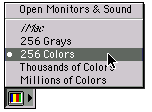
Adjusting the Control Strip - The control strip may be in your way if it is left open. The strip can be collapsed by placing the tip of your mouse pointer on the series of dots at the far right end of the strip and gently clicking one time. Only the button containing the dots will be displayed at the left side of your screen. To bring the strip back out, reverse the procedure; place the tip of your mouse pointer on the control strip icon and gently click one time. If the strip only shows a few buttons, put the tip of your mouse pointer on the control strip icon, click the mouse button and leave it depressed, then drag the icon to the right.
Task - Open Key Caps, set the font to Wingdings, and find the keystroke combination to produce the oriental yin/yang symbol.
Mouse | Windows | Desktop | Built-In | Formatting a Disk | Saving | Keyboard
 Custom Search
Custom Search
Visitors since November 2000
Memphis, TN
Internet4Classrooms is a collaborative project developed by Susan Brooks and Bill Byles
Return to Internet4Classrooms home